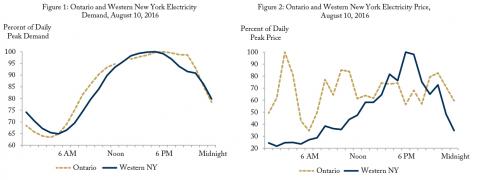From: Benjamin Dachis
To: Ontario Ministry of Energy
Date: August 17, 2016
Subject: Ontario should let prices lead to energy savings, not arbitrary rules
Last week was a hot one in Ontario. People cranked up their air conditioning, made dinner, and turned on the TV to watch the Olympics. It meant 6 PM on August 10th was the peak electricity demand hour so far this year (Figure 1).
But many businesses across Ontario scrambled to cut their electricity use. Why?
The Ontario government created a policy in which certain large electricity consumers can slash their annual electricity costs if they cut their electricity use – or use onsite backup generators – during the five top Ontario-wide electricity demand hours of the year. A C.D. Howe Institute study found that the effective cost for a business to use electricity during one of these hours in previous years was an eye-watering $52,337/MWh.
If there’s any day that we’d expect the market price of electricity to be the highest, it’s when demand is highest. But Ontario prices that day never went past the morning price peak of $59/MWh even as demand peaked (Figure 2). Perhaps the policy worked to cut back on demand. The system operator turned to twitter to announce electricity demand every five minutes when its data portal crashed. Or, maybe electricity supply ramped up to meet demand.
Ontario businesses can look across the border to Western New York to see market prices in action. It was hot there too on the 10th, and demand looked the same as Ontario’s. The price there peaked when demand was highest. Businesses there had the choice of using electricity at a high, but not unreasonable, $US 99/MWh.
Ontario’s price of electricity was low in comparison during the peak hour because the government gave some large businesses big discounts to cut their use on the 10th, based on an arbitrary rule, rather than because the cost of producing electricity was high at that time. In reality, the price of electricity is too low during those periods, meaning that the price of electricity is too high the rest of the year.
Ontario should let innovative companies like Nest pay businesses and consumers to ease up on their air conditioning for a few minutes based on the price of electricity – not an arbitrary threshold.
Source: Authors’ calculations from Ontario and New York Electricity System Operators
Benjamin Dachis is Associate Director, Research, at the C.D. Howe Institute
To send a comment or leave feedback, email us at blog@cdhowe.org.






